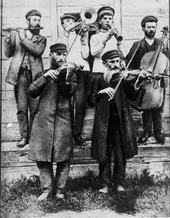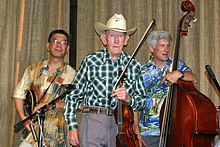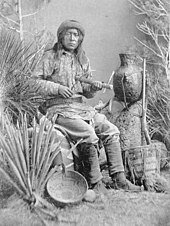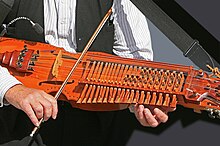Fiddle
For example, fiddles may optionally be set up with a bridge with a flatter arch to reduce the range of bow-arm motion needed for techniques such as the double shuffle, a form of bariolage involving rapid alternation between pairs of adjacent strings.
Fiddling is also open to improvisation and embellishment with ornamentation at the player's discretion, in contrast to orchestral performances, which adhere to the composer's notes to reproduce a work faithfully.
The earliest pictures of violins, albeit with three strings, are seen in northern Italy around 1530, at around the same time as the words "violino" and "vyollon" are seen in Italian and French documents.
One of the earliest explicit descriptions of the instrument, including its tuning, is from the Epitome musical by Jambe de Fer, published in Lyon in 1556.
The fiddle proved very popular among both street musicians and the nobility; the French king Charles IX ordered Andrea Amati to construct 24 violins for him in 1560.
[13] In performance, a solo fiddler, or one or two with a group of other instrumentalists, is the norm, though twin fiddling is represented in some North American, Scandinavian, Scottish and Irish styles.
[18] Hungarian, Slovenian, and Romanian fiddle players are often accompanied by a three-stringed variant of the viola—known as the kontra—and by double bass, with cimbalom and clarinet being less standard yet still common additions to a band.
In Hungary, a three-stringed viola variant with a flat bridge, called the kontra or háromhúros brácsa makes up part of a traditional rhythm section in Hungarian folk music.








